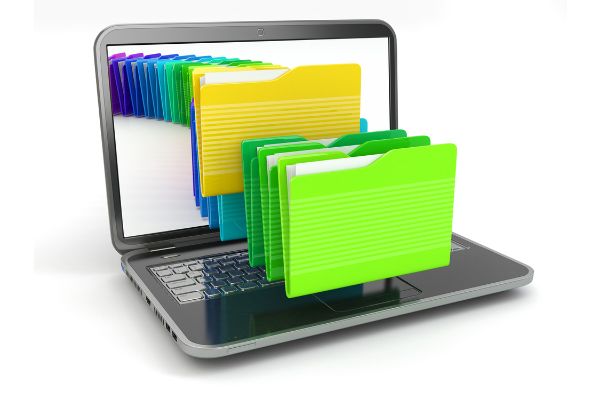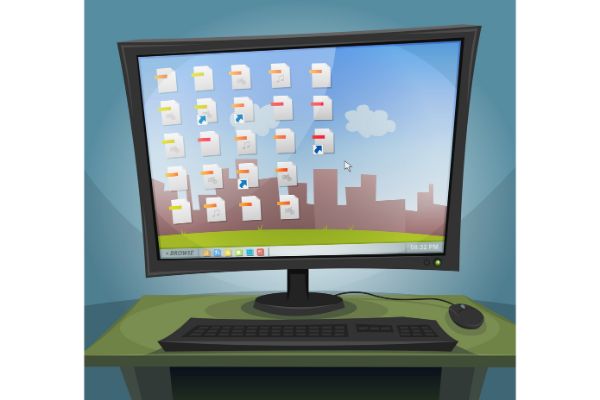Disclaimer: This post may contain affiliate links, meaning we get a small commission if you make a purchase through our links, at no cost to you. For more information, please visit our Disclaimer Page.
Although we call most standalone computers desktops, there is another version of the desktop within the device itself. When you boot up your computer, the main home screen you look at once you get past any security authentication or loading tiles is also your desktop.
In general, this is where most users will keep folders with files that they use regularly, shortcuts to programs they want to find or access easily, and a taskbar that helps them access other functions within the operating system. You also have the ability to customize this place with different backgrounds that suit your tastes.
Because the desktop is one of the primary stops on your way to anything else in the computer’s system, you may wonder if having lots of things on it slows the whole thing down at all. We will dive into this topic in today’s article.
At the same time, we will discuss whether keeping large files directly on the desktop can also contribute to slowing the system down, speak about shortcuts, animated wallpapers, and talk about similar things that could cause your computer some issues.
On a related note, we will talk about common reasons why your computer might slow down in general, and we will take you through a way to see which programs might be causing a slowdown directly.
Table of Contents
Does Having a Lot of Programs Slow Down a Computer?
Yes, having lots of programs on your computer might slow it down. However, this is not necessarily a given. It also depends on a few factors, and we will take you through some of them here:
1. If you have lots of programs that are on the same storage media as the operating system itself, your computer could seem to run a bit sluggishly. This is particularly true if you’ve installed enough programs to take up almost all the space available on your hard disk.
Your disk should partition enough of its own space for the OS itself, but it is always good to keep some of it available to help the memory run files or programs as needed.
A full or nearly full hard disk could cause the system to have a hard time keeping up, especially if you’re asking the same storage device to run the OS along with all of your programs.
2. Programs that are running are more intense on the memory and other system resources than programs that are just installed there.
Therefore, you would see the most pronounced slow operations from your computer if you are running several large programs at once. This takes up more of the system memory, and it could cause the machine to seem like it is not as effective as it is when it operates at the usual level that you know.
3. We touched on having some space available, and part of the reason why you need this extra space is to help the paging file allocate memory for operations when you run out of other kinds.
If you don’t have that space, or if you are running too many programs at once, there is no more room for the memory that you need.
The problem here relates to how operating systems work. They function by doing a kind of memory swap in order to move data from the physical RAM to the paging file. However, this is not as efficient as the RAM you have in your computer. If your OS must use the paging file, this action will impact its performance.
Does Keeping Large Files on the Desktop Slow Computer?
Before we get into storing large files on the desktop, we should clear up a point about this space. All files in your computer are on your disk drive somewhere. Sometimes, this could include the directory that includes your desktop.
Once there are files on your desktop itself, they link to the space inside the appropriate directory. In a way, you are storing things in the appropriate hard disk directory and setting up a quick way to access them via the desktop. This keeps you from having to go into the long form of the directory to find them.
However, storing lots of things here can slow your computer down. Just as before, this is not a given, but the likelihood increases with the more stuff you decide to store here. A big part of the reason for this is in how the computer behaves on boot.
When your machine starts up, part of its process is to scan everything that is on the desktop. As you might imagine, if you have several programs on there, or several gigabytes of data, the computer might take much longer to scan all of this and start itself up.
One thing you can do is to create shortcuts that lead to other directories. That way, the computer only has to scan for the presence of the shortcuts themselves. In theory, this should be much quicker than scanning all of the data in the desktop directory itself.
Furthermore, too much data in this one directory might degrade the speed and performance of your system overall, not just the time it takes for it to start itself up. Therefore, it might be better to create a separate partition for large files, and you can just use shortcuts to access them when necessary.
Does Having Lots of Shortcuts on Desktop Slow Computer?
As we just read, shortcuts can be very useful. However, it is possible that clogging up too many of them on the desktop can lead to performance issues. However, this is not something that you should see constantly. At most, you might see spikes in the usage when it comes to your computer’s memory.
This would lead to slower performance from the system overall for a while. Having said that, things should return to normal with relative ease, even if you do have lots of shortcuts on your desktop.
However, you should keep in mind that the computer still needs to take time to scan everything on the desktop when it boots. The more shortcuts you have, the longer it may take for the device to complete its boot process.
With performance in general, it may be that you could see some issues if you have hundreds of tiny icons for shortcuts that you have inserted into your desktop screen. So, there might be a performance limit on precisely how many icons you can keep on your desktop.
If you do seem to experience issues like this, try deleting some of the icons in incremental blocks of numbers. You should see some kind of improvement overall, particularly during the startup sequence.
Do Animated Wallpapers Slow Down a PC?
Animated wallpapers can be a great resource for spicing up your desktop. Because they are not static, some people also call them live wallpapers. In truth, a live wallpaper could slow down the performance of your PC. It has more to do with the specs of your system than it does the wallpaper itself.
There are programs that can help your computer run animated wallpapers. The resolution and type of wallpaper might be quite impactful when it comes to how your system can handle it. Furthermore, there are some settings you can customize, including the frames at which the wallpaper runs each second. All of these things can impact how your system performs with an animated wallpaper.
The settings or specs for your central processor or graphics processor can be just as important here, however. If you are running several resource-intensive programs in the background while the live wallpaper is active, you may see a dip in performance.
This is particularly true if you are running games and things while the wallpaper is active. However, there might be ways around this problem, too.
If you are able to access the settings for whatever engine controls your live wallpaper, you can limit how much it uses the animation itself. Additionally, you can tell the live action to pause itself automatically when certain programs run on the computer.
That way, you still have easy access to some of your favorite animations, but they will not cause any dip in your performance when you are running games and other programs.
What Are the Common Reasons for a Slow Desktop Computer?
A lack of space can lead to your computer running slowly, but let’s take a look at some of the other possibilities in this category, too. Although our list may not cover every eventuality, here are some of the most common issues you might face:
1. Antivirus scans are important, but they may slow down your system. They are quite intense in their use of resources, and they need to scan every single file on your PC for potential issues or breaches. Instead of letting them run in the background, you can schedule times for scans when you are not using the computer for other things.
2. We touched on it briefly, but startup programs can slow things down. They definitely slow down your computer’s boot process, but they can also slow down its general performance. This is because all of those programs will continue to try running after you start and use the PC. Blocking some of these from the startup process could improve the health and performance of your machine.
3. Like many people, you probably use the internet for work and entertainment. If so, it could hog resources without you realizing it. This is especially true if you have many tabs open in a browser window. Try closing some of them to free up resources.
How Can I See Which Programs Are Slowing Down My Computer?
Use the Control Panel or keyboard shortcuts to find the Task Manager and activate it. This program will show you everything else that is running in the background of your computer. Look for temporary spikes in CPU and memory usage.
Furthermore, look for the programs that go to the tops of these categories and stay there. They are the ones that impact your system the most. If you can, try closing these applications to see if you get a boost in performance.
Conclusion
For the most part, things on your desktop should not slow it down too much. If you have limited system memory and storage, this could turn it into a bigger issue. Additionally, hundreds of small shortcuts or running an animated wallpaper could cause some dips, but there are ways to freeze or alleviate these problems. You can also look at which applications use the most resources, even when you may not be engaging with them actively.


